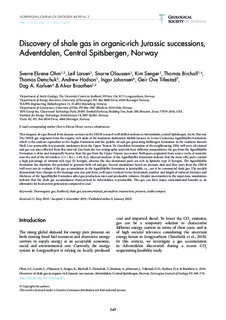| dc.contributor.author | Ohm, Sverre Ekrene | |
| dc.contributor.author | Larsen, Leif | |
| dc.contributor.author | Olaussen, Snorre | |
| dc.contributor.author | Senger, Kim | |
| dc.contributor.author | Birchall, Thomas | |
| dc.contributor.author | Demchuk, Thomas | |
| dc.contributor.author | Hodson, Andrew | |
| dc.contributor.author | Johansen, Ingar | |
| dc.contributor.author | Titlestad, Geir Ove | |
| dc.contributor.author | Karlsen, Dag Arild | |
| dc.contributor.author | Braathen, Alvar | |
| dc.coverage.spatial | Spitsbergen | nb_NO |
| dc.date.accessioned | 2020-02-07T12:31:14Z | |
| dc.date.available | 2020-02-07T12:31:14Z | |
| dc.date.created | 2019-11-19T11:51:36Z | |
| dc.date.issued | 2020-01 | |
| dc.identifier.citation | Norwegian Journal of Geology. 2019, 99 (2), 349-376. | nb_NO |
| dc.identifier.issn | 2387-5844 | |
| dc.identifier.uri | http://hdl.handle.net/11250/2640434 | |
| dc.description.abstract | Thermogenic dry gas flowed from Jurassic sections in the DH5R research well drilled onshore in Adventdalen, central Spitsbergen, Arctic Norway. The DH5R gas originates from the organic-rich units of the mudstone-dominated Middle Jurassic to Lower Cretaceous Agardhfjellet Formation, which is the onshore equivalent to the Fuglen Formation and the prolific oil and gas generating Hekkingen Formation in the southern Barents Shelf. Low-permeable, low-porosity sandstones from the Upper Triassic De Geerdalen Formation of the neighbouring DH4 well were oil-stained and gas was also collected from this interval. Gas from the two stratigraphic intervals have different compositions; the gas from the Agardhfjellet Formation is drier and isotopically heavier than the gas from the Upper Triassic succession. Both gases originated from source rocks of maturity near the end of the oil window (1.1 < Ro < 1.4% Ro). Maceral analyses of the Agardhfjellet Formation indicate that the more silty parts contain a high percentage of vitrinite-rich type III kerogen, whereas the clay-dominated parts are rich in liptinitic type II kerogen. The Agardhfjellet Formation has therefore the potential to generate both oil and gas. Several simulations based on pressure data and flow rates from the DH5R well were run to evaluate if the gas accumulation in the Agardhfjellet Formation is producible, i.e., can it be commercial shale gas. The models demonstrate how changes in the drainage area size and form, well types (vertical versus horizontal), number and length of induced fractures and thickness of the Agardhfjellet Formation affect gas production rates and producible volumes. Despite uncertainties in the input data, simulations indicate that the shale gas accumulation characterised in Adventdalen is producible. This gas can have major environmental benefits as an alternative for local power generation compared to coal. | nb_NO |
| dc.language.iso | eng | nb_NO |
| dc.publisher | Geologial Society of Norway | nb_NO |
| dc.rights | Navngivelse 4.0 Internasjonal | * |
| dc.rights.uri | http://creativecommons.org/licenses/by/4.0/deed.no | * |
| dc.subject | geologi | nb_NO |
| dc.subject | shale gas | nb_NO |
| dc.title | Discovery of shale gas in organic rich Jurassic successions, Adventdalen, Central Spitsbergen, Norway | nb_NO |
| dc.type | Journal article | nb_NO |
| dc.type | Peer reviewed | nb_NO |
| dc.description.version | publishedVersion | nb_NO |
| dc.rights.holder | © Copyright the authors. | nb_NO |
| dc.subject.nsi | VDP::Mathematics and natural science: 400::Geosciences: 450 | nb_NO |
| dc.source.pagenumber | 349-376 | nb_NO |
| dc.source.volume | 99 | nb_NO |
| dc.source.journal | Norwegian Journal of Geology | nb_NO |
| dc.source.issue | 2 | nb_NO |
| dc.identifier.doi | 10.17850/njg007 | |
| dc.identifier.cristin | 1749315 | |
| dc.relation.project | Norges forskningsråd: 228107 | nb_NO |
| cristin.unitcode | 217,8,11,0 | |
| cristin.unitname | Institutt for energiressurser | |
| cristin.ispublished | true | |
| cristin.fulltext | original | |
| cristin.qualitycode | 1 | |

